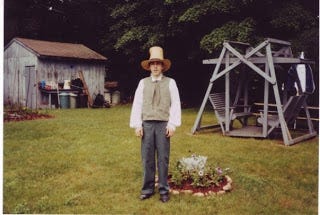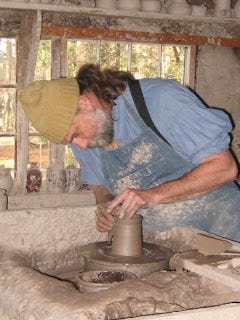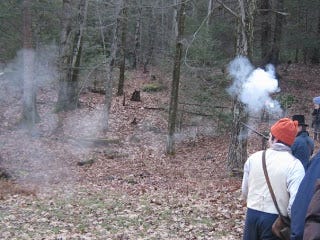This post is a tribute to John Durant, Melissa McEwen, and Stephan Guyenet, each of whom brought a whopping pile of curiosity, friendship, and comradery to the 2010 Wise Traditions conference. Stephan also brought a whopping pile of genius, which he injected into his excellent presentation on traditional diets in the Pacific islands, showing that neither carbs, fat, nor saturated fat make you fat, but rather that modern, refined, industrial foods bring in the diseases of modern civilization.
John Durant has declared his official opposition to caveman role playing, found here. Apparently loin cloths will not sell the public on paleo. Ho humph. So much for comfy clothing.
How about a tall straw hat to sell the public on the 1830s New England digestion-deranging traditional diet? It was full of sugar, but probably better than what's found on American's plates today.
I used to work at Old Sturbridge Village (OSV), a living history museum set in the 1830s. Here's me in my work clothes:
At OSV I learned to operate carding, grist, and saw mills, to bottom shoes by hand, and to make pottery, like this guy is doing:
I also learned to put a leash on a calf to take her for a walk (not so easy as it sounds!), to mow grass with a scythe (walking a calf is a lot easier!), and to fire a black powder musket, like this one:
The 1830s were a time of bustling change. Andrew Jackson, who ran on the campaign “Jackson and No Bank,” became president in 1828, and achieved the destruction of America's second central bank by 1836. 1830s America had a number of competing coin currencies:
The progression of capitalism enhanced the ability of women to play an important role in society (in addition to their direct contributions to their family). The advent of carding mills and other semi-automated processes freed up time that women could use to engage in social and reform movements:
The political scene looked very different. 90% of taxes went to the municipality, and those funds were allocated by direct democracy. The separation of church and state was taken as literally stated in the first amendment and had no application to municipalities, so often each town had an official church. It wasn't so terrible, because it's a lot easier to move to a different town than a different country, if you want your taxes to go to your own religion. Poverty was confronted rather than swept under the rug. Anyone who couldn't work was taken care of by a family, paid for by the town taxes. Whichever family volunteered to take care of the indigent for the lowest price got the contract.
Here are a few things I learned about the New England Diet while I was there:
They ate an awful lot of meat, and considered a “good” diet to be one that was high in meat and flour.
Vegetables and fruits were considered “garnish” unless they could be elevated in status by mixing with flour and sugar, as in an apple pie.
Their “white meat” was cheese, fish, and butter, and its status was above sugars but below meats and grains.
They drank very little milk, but made lots of cheese and butter.
Wheat didn't grow in the region, but the rich people could buy it, as it was beginning to be imported from Rochester and Baltimore. Most folks made bread from corn and rye. The bread was so tough that they used it as a utensil. For example, they would cut off a more or less spoon-shaped piece and use it to eat their soup.
Most people ate with their knife; they used their fork to get the food onto the knife.
Their foods were preserved in vinegar, not by lacto-fermentation.
They ate a lot. When Alexis de Tocqueville visited America he remarked that Americans were noted for the huge portions of food they consume.
Their number one health complaint was digestive problems.
The best thing about this diet? They ate tons of organ meats.
I suppose to my credit, John might consider this “leaving it to the professionals,” since I did in fact get a paycheck. But I'd encourage anyone who swings by central Massachusetts to take a stroll through OSV.
If you're in for a laugh, our sister living history museum, Pioneer Village, was featured on an episode of South Park:
Enjoy!








